Medial Crease: Since clubfoot forms a severe cave-like position, it results in one prominent deep crease. When a single deep crease is found the Pirani score is one. With gentle manipulation and casting with the foot in a supinated position, this deep crease will gradually lessen. Even after the foot is corrected and ready for tenotomy, there are chances that a few creases will still remain. That is the reason in the timing for the determination of tenotomy, it is said that the midfoot score could be less than one and need not be zero, because there are chances that the medial crease still scores 0.5 and may not come to zero within those four to five or six weeks. When several fine creases remain, the medial crease score comes to zero.
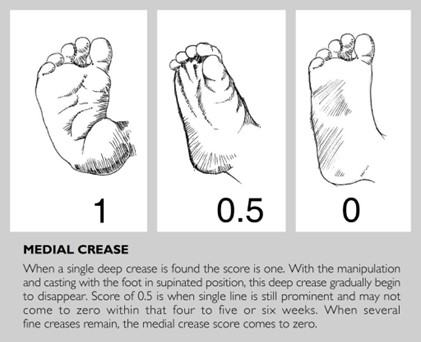
Head of Talus: In the deformed position the head of the talus is very prominent. For a free kinematic coupling movement, the fulcrum while manipulation and casting has to be the head of the talus. It is important that the head of talus score moves from point one to zero along with the correction of the foot. It is only when the head of the talus score is zero that a tenotomy can be performed.
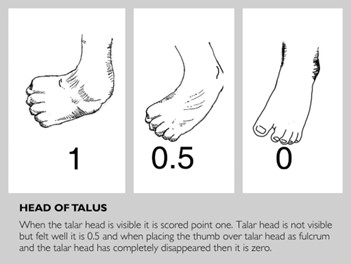
Curved Lateral Border: In clubfoot the midfoot is twisted inward, and the lateral border (outside) of the foot is curved inward. In the course of manipulation and casting, when the foot is brought to the normal position it is important that the lateral border is brought straight. While scoring lateral border, it is important that the foot is not held; the foot has to be left free. In the Pirani score, when the border is far away from a straight line (scale/pen) the Pirani score is one. If the curved lateral border is coming close to a parallel line, the score is 0.5 and when the lateral border comes exactly parallel to a straight line, the point comes to zero. When the score is zero it means that the foot is now brought to a normal position. It is important to make sure that the curved lateral border score is brought to zero before the tenotomy.
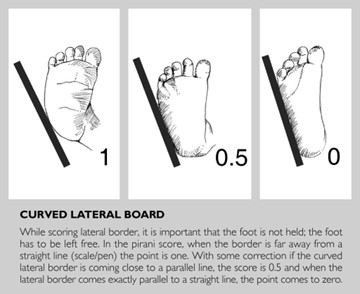
Posterior Crease: Lines that are seen above the heel are called the posterior crease. In clubfoot, since the tendon is short, the equines are rigid and instead of several creases, one deep crease appears. The depth of such a deep crease is not visible. If there is such a prominent crease the score is a one. If there are two or three not-so-deep crease, the score is 0.5. no crease is a score of zero.
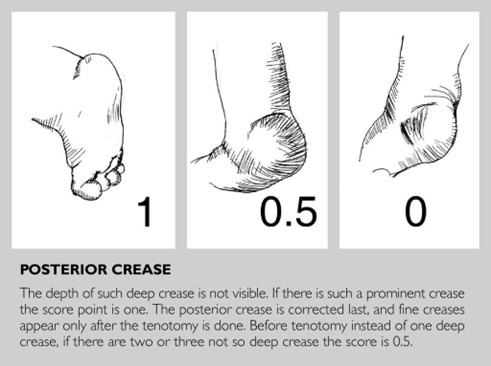
Empty Heel: The score is recorded by feeling the calcaneus (bone in the heel). The calcaneus bone has to be felt not from the sole side or the lateral side, but 45 degrees on the hind side. The amount of tissue and flesh between the finger and the calcaneus bone determines the score. In clubfoot, the calcaneus is moved to a position so that we won’t be able to feel it well because of the tissue. So when we try to feel the calcaneus, we don’t get to feel the bone. It is technically called ‘empty heel’. However, when the cavus and adductus are corrected, the calcaneus gets corrected automatically and the heel bone begins to be prominent.
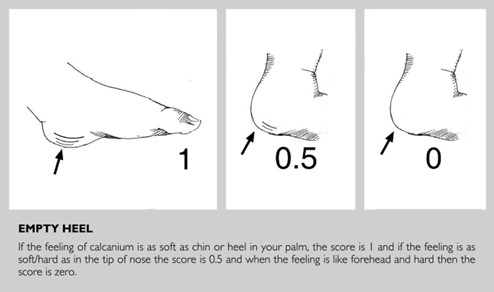
Rigid Equinus: The ankle is so rigid in clubfoot because of the short tendon. Since the rigidity of the equines is corrected with tenotomy the Pirani score of Rigidity of Equines remains one or 0.5 all through the weekly plaster casting. Only after tenotomy will the score go from one to zero. It is very important to know that the rigidity of equines should not be corrected with manipulation or casting. If too much pressure is given to correct equines by manipulation and casting, the foot will result in a rocker bottom foot or it even lead to atypical clubfoot. After correcting plantar flex the dorsiflexion is measured.
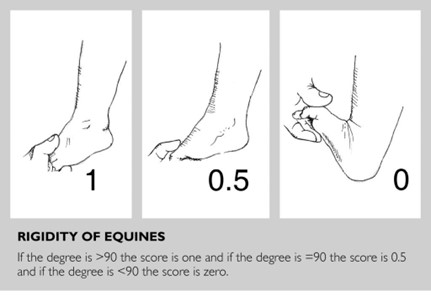
Site by NWD.